A Gas-Kinetic BGK Scheme for Natural Convection in a Rotating Annulus
Abstract
1. Introduction
2. Numerical Method
2.1. BGK Model for Natural Convection in a Rotating Annulus
2.2. Gas-Kinetic BGK Scheme for the Time-Dependent Solution
2.3. Evaluations of Numerical Fluxes and Update of Flow Variables
3. Numerical Results and Discussions
3.1. Problem Description
3.2. Nusselt Numbers
3.3. Flow Pattern
3.4. Effect of Step Size
4. Conclusions
Author Contributions
Acknowledgments
Conflicts of Interest
References
- Childs, P.R.N. Introduction to rotating flow. In Rotating Flow; Butterworth-Heinemann: Oxford, UK, 2011. [Google Scholar]
- Bohn, D.; Emunds, R.; Gorzelitz, V.; Krüger, U. Experimental and theoretical investigations of heat transfer in closed gas-filled rotating annuli II. In Proceedings of the ASME 1994 International Gas Turbine and Aeroengine Congress and Exposition, The Hague, The Netherlands, 13–16 June 1994; Volume 4, p. V004T009A027. [Google Scholar]
- Bohn, D.; Deuker, E.; Emunds, R.; Gorzelitz, V. Experimental and theoretical investigations of heat transfer in closed gas-filled rotating annuli. J. Turbomach. 1995, 117, 175–183. [Google Scholar] [CrossRef]
- King, M.P. Convective Heat Transfer in a Rotating Annulus; University of Bath: Bath, UK, 2002. [Google Scholar]
- Bohn, D.; Dibelius, G.H.; Deuker, E.; Emunds, R. Flow pattern and heat transfer in a closed rotating annulus. J. Turbomach. 1994, 116, 542–547. [Google Scholar] [CrossRef]
- King, M.P.; Wilson, M.; Owen, J.M. Rayleigh-bénard convection in open and closed rotating cavities. J. Eng. Gas Turbines Power 2007, 129, 305–311. [Google Scholar] [CrossRef]
- Hasan, N.; Sanghi, S. The dynamics of two-dimensional buoyancy driven convection in a horizontal rotating cylinder. J. Heat Transf. 2005, 126, 963–984. [Google Scholar] [CrossRef]
- Hasan, N.; Sanghi, S. On the role of coriolis force in a two-dimensional thermally driven flow in a rotating enclosure. J. Heat Transf. 2006, 129, 179–187. [Google Scholar] [CrossRef]
- Sun, Z.; Kifoil, A.; Chew, J.W.; Hills, N.J. Numerical simulation of natural convection in stationary and rotating cavities. In Proceedings of the ASME Turbo Expo 2004: Power for Land, Sea, and Air, Vienna, Austria, 14–17 June 2004; Volume 4, pp. 381–389. [Google Scholar]
- Michael Owen, J.; Long, C.A. Review of buoyancy-induced flow in rotating cavities. J. Turbomach. 2015, 137, 111001–111013. [Google Scholar] [CrossRef]
- Su, M.; Xu, K.; Ghidaoui, M.S. Low-speed flow simulation by the gas-kinetic scheme. J. Comput. Phys. 1999, 150, 17–39. [Google Scholar] [CrossRef][Green Version]
- Xu, K.; He, X. Lattice boltzmann method and gas-kinetic bgk scheme in the low-mach number viscous flow simulations. J. Comput. Phys. 2003, 190, 100–117. [Google Scholar] [CrossRef]
- Jin, C.; Xu, K.; Chen, S. A three dimensional gas-kinetic scheme with moving mesh for low-speed viscous flow computations. Adv. Appl. Math. Mech. 2010, 2, 746–762. [Google Scholar]
- Prendergast, K.H.; Xu, K. Numerical hydrodynamics from gas-kinetic theory. J. Comput. Phys. 1993, 109, 53–66. [Google Scholar] [CrossRef]
- Xu, K. Gas-Kinetic Schemes for Unsteady Compressible Flow Simulations; Lecture Series; van Kareman Institute for Fluid Dynamics: Rhode-Saint-Genese, Belgium, 1998; Volume 3. [Google Scholar]
- Xu, K.; Lui, S.H. Rayleigh-bénard simulation using the gas-kinetic bhatnagar-gross-krook scheme in the incompressible limit. Phys. Rev. E 1999, 60, 464. [Google Scholar] [CrossRef]
- Tian, C.T.; Xu, K.; Chan, K.L.; Deng, L.C. A three-dimensional multidimensional gas-kinetic scheme for the navier–stokes equations under gravitational fields. J. Comput. Phys. 2007, 226, 2003–2027. [Google Scholar] [CrossRef]
- Wang, P.; Tao, S.; Guo, Z. A coupled discrete unified gas-kinetic scheme for boussinesq flows. Comput. Fluids 2015, 120, 70–81. [Google Scholar] [CrossRef]
- Wang, P.; Zhang, Y.; Guo, Z. Numerical study of three-dimensional natural convection in a cubical cavity at high rayleigh numbers. Int. J. Heat Mass Transf. 2017, 113, 217–228. [Google Scholar] [CrossRef]
- Zhou, D.; Lu, Z.L.; Guo, T.Q. Development of a moving reference frame-based gas-kinetic bgk scheme for viscous flows around arbitrarily moving bodies. J. Comput. Phys. 2018. under review. [Google Scholar]
- Xu, K. A gas-kinetic scheme for the euler equations with heat transfer. SIAM J. Sci. Comput. 1999, 20, 1317–1335. [Google Scholar] [CrossRef]
- Blazek, J.Z. Structured finite volume schemes. In Computational Fluid Dynamics: Principles and Applications, 2nd ed.; Elsevier Science: Amsterdam, The Netherlands, 2005; pp. 210–213. [Google Scholar]
- Xu, K. A gas-kinetic bgk scheme for the navier–stokes equations and its connection with artificial dissipation and godunov method. J. Comput. Phys. 2001, 171, 289–335. [Google Scholar] [CrossRef]
- Hollands, K.G.T.; Raithby, G.D.; Konicek, L. Corrrelation equations for free convection heat transfer in horizontal layers of air and water. Int. J. Heat Mass Transf. 1975, 18, 879–884. [Google Scholar] [CrossRef]
- Balescu, R. Neoclassical Tarnsport Theory. In Transport Processes in Plasmas; North-Holland Publishing Company: Amsterdam, The Netherlands, 1988; Volume 2. [Google Scholar]
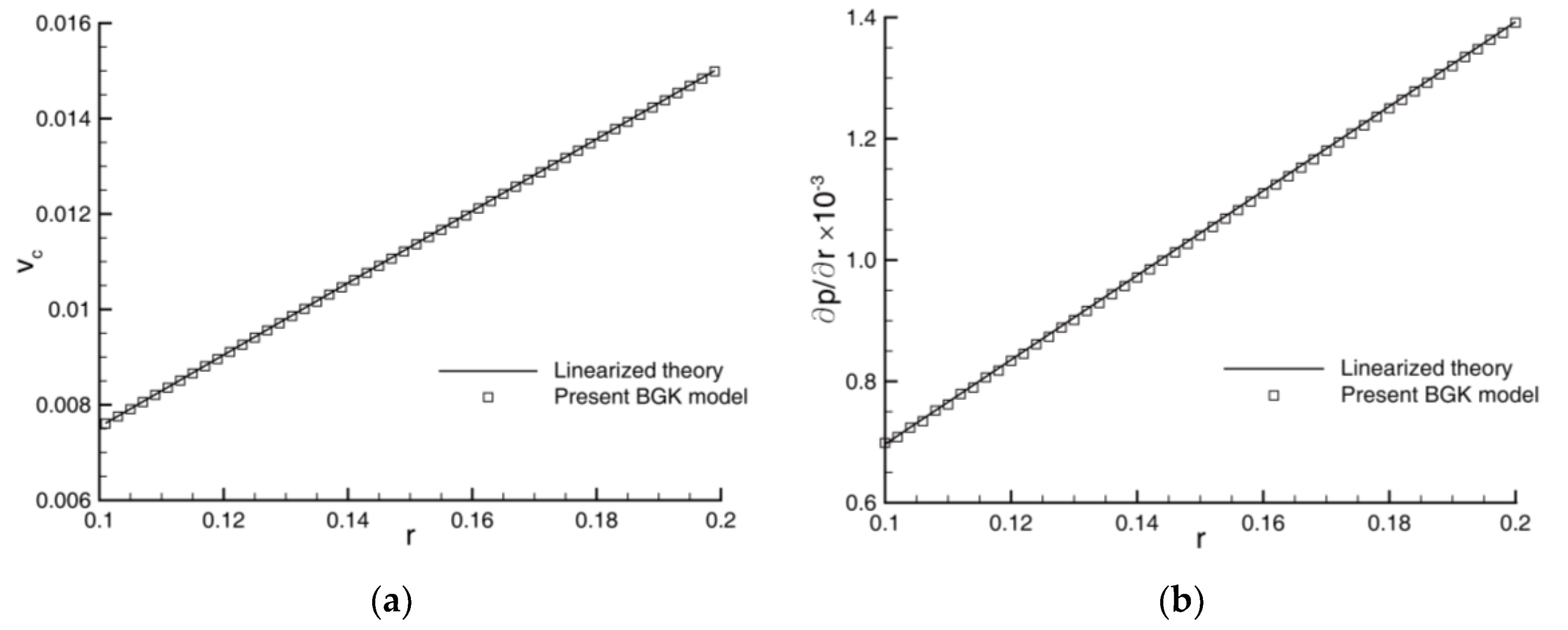
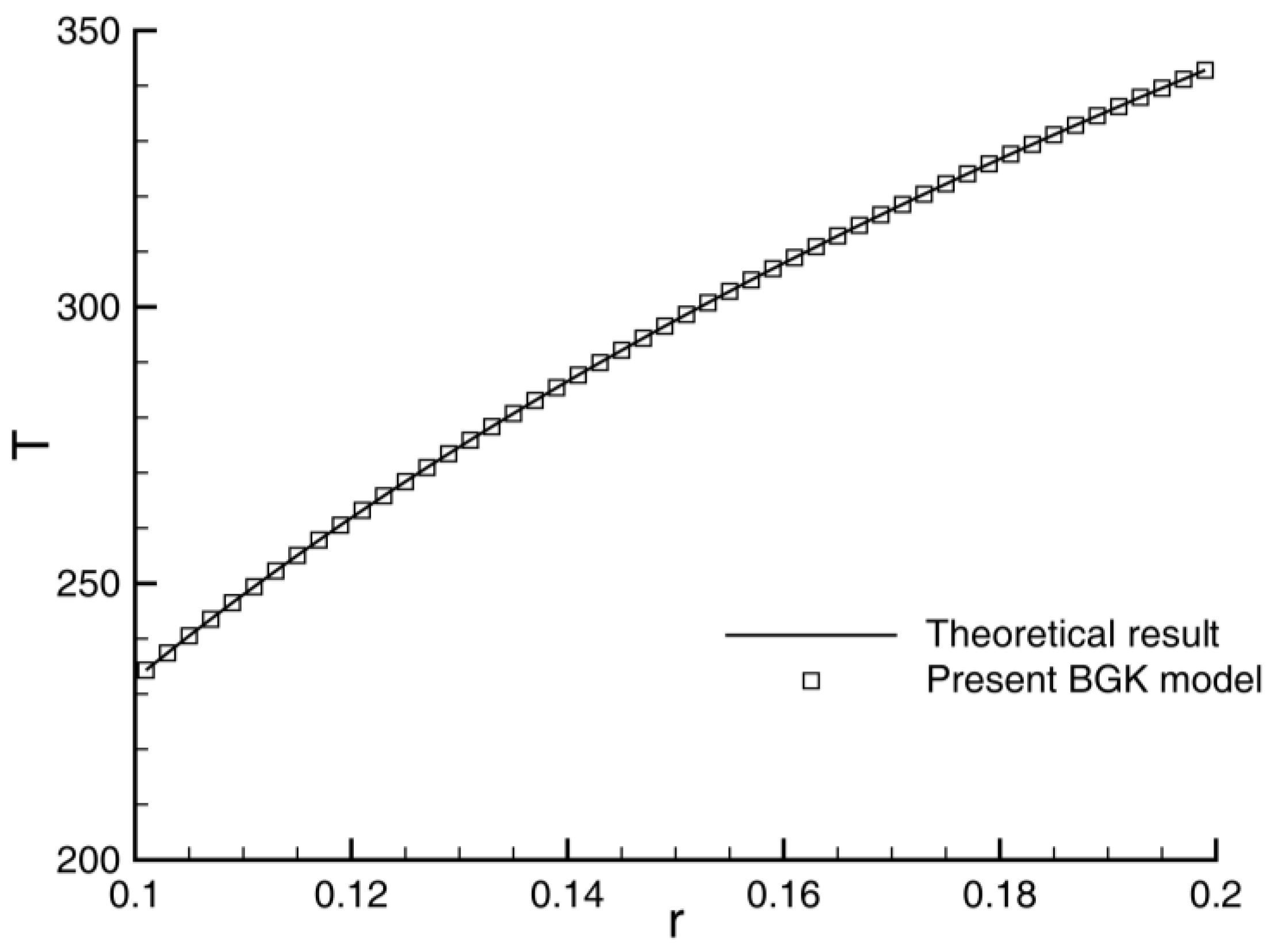
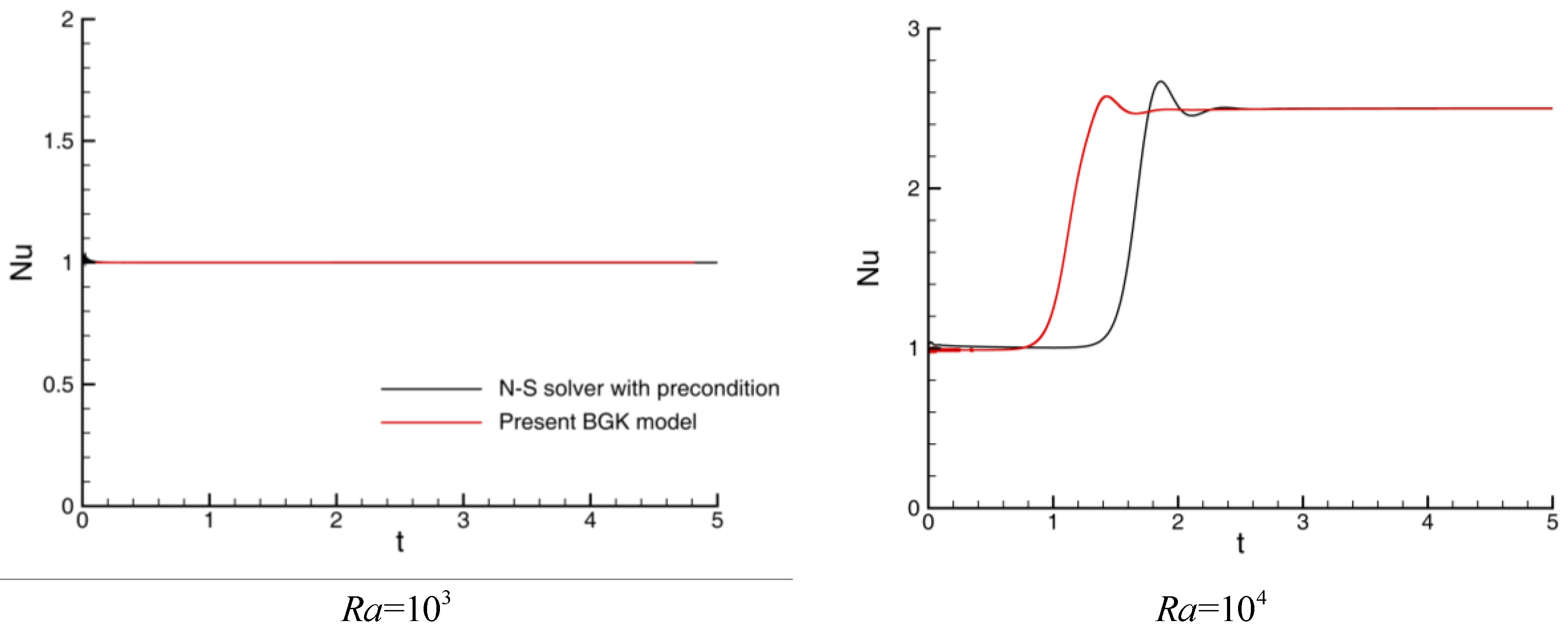

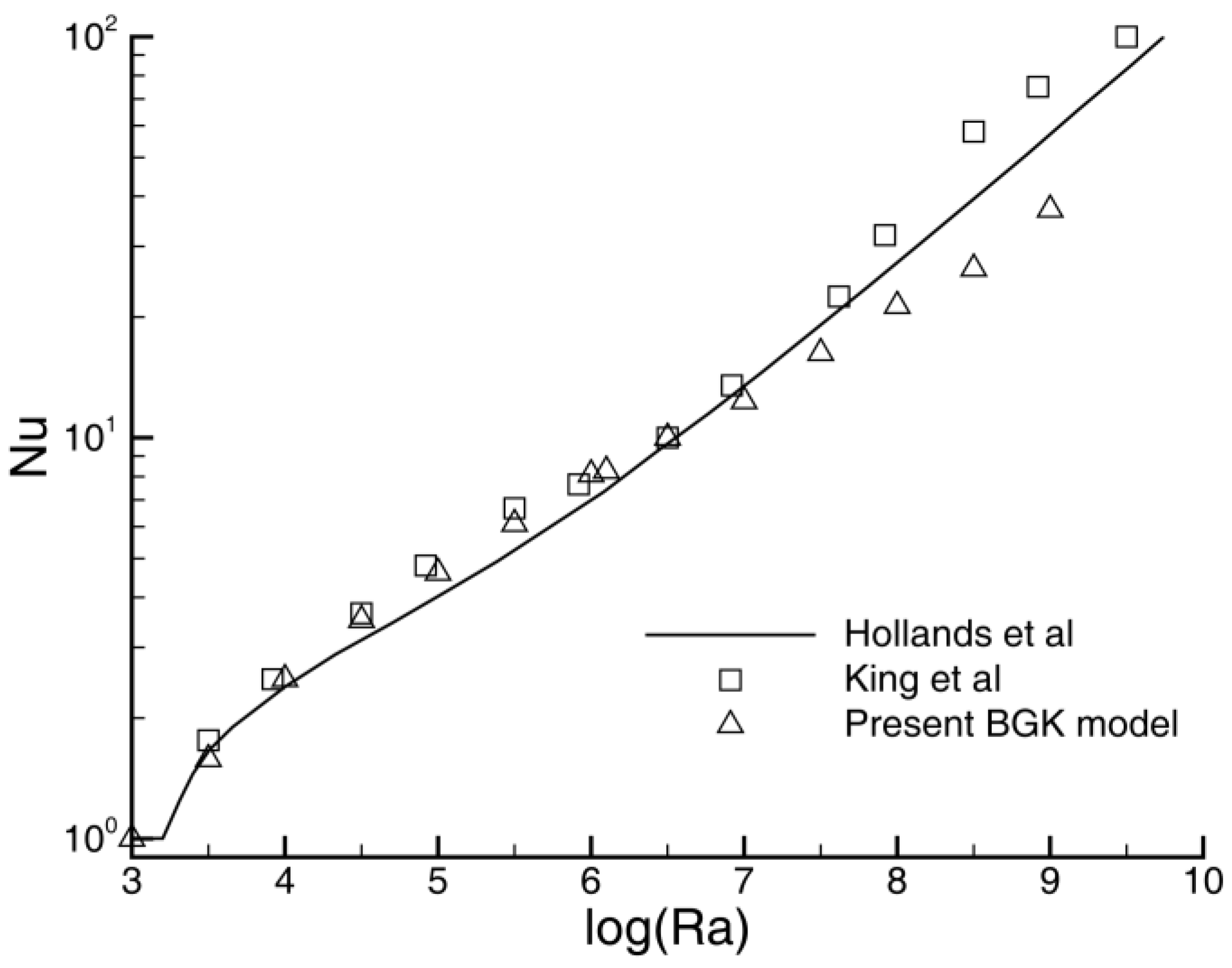


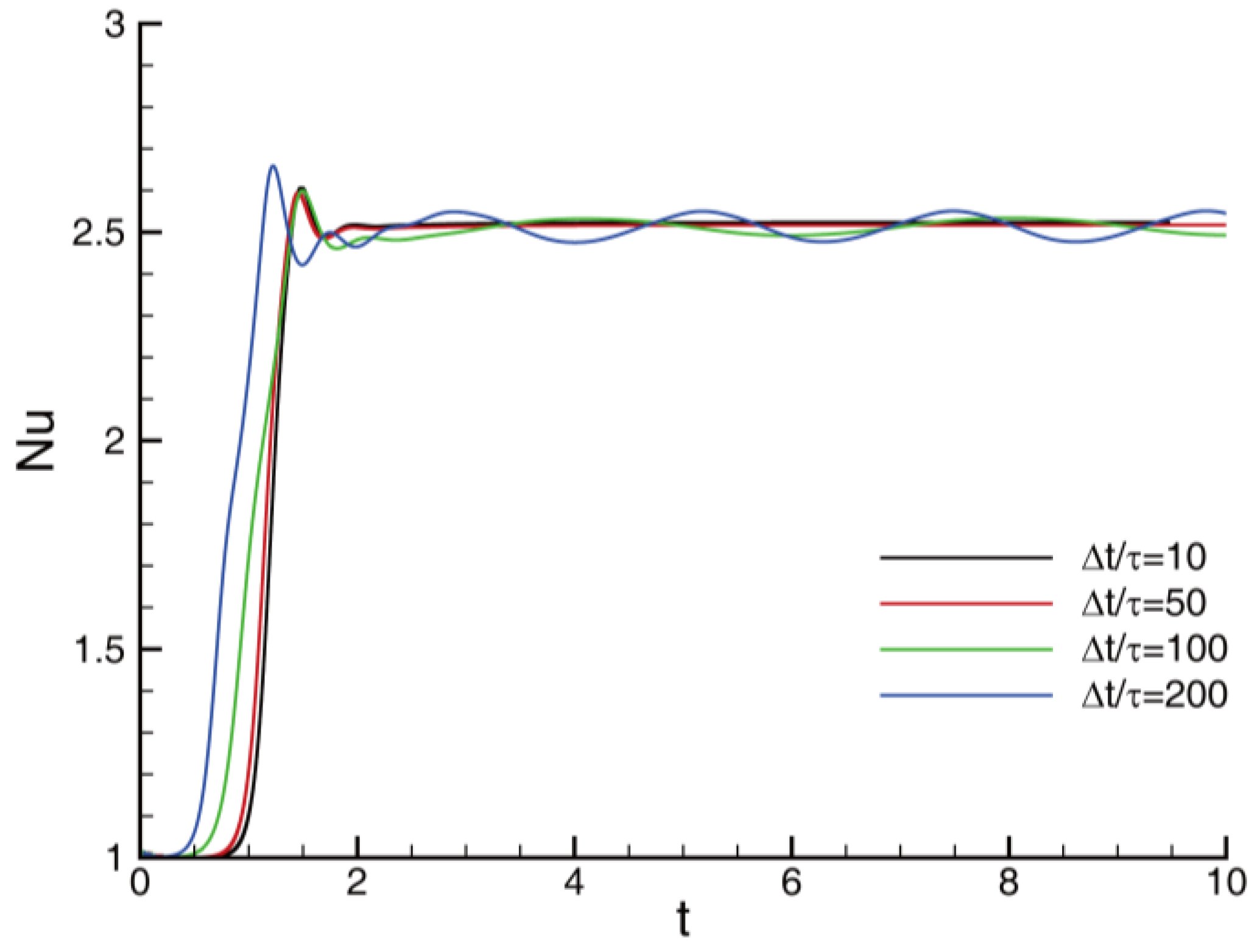
| Quantity | Constant Value |
|---|---|
| Inner radius | 100 mm |
| Outer radius | 200 mm |
| Reference length | 150 mm |
| Reference temperature | 288.15 K |
| Volume expansion coefficient | |
| Kinematic viscosity | |
| Thermal diffusivity |
© 2018 by the authors. Licensee MDPI, Basel, Switzerland. This article is an open access article distributed under the terms and conditions of the Creative Commons Attribution (CC BY) license (http://creativecommons.org/licenses/by/4.0/).
Share and Cite
Zhou, D.; Lu, Z.; Guo, T. A Gas-Kinetic BGK Scheme for Natural Convection in a Rotating Annulus. Appl. Sci. 2018, 8, 733. https://doi.org/10.3390/app8050733
Zhou D, Lu Z, Guo T. A Gas-Kinetic BGK Scheme for Natural Convection in a Rotating Annulus. Applied Sciences. 2018; 8(5):733. https://doi.org/10.3390/app8050733
Chicago/Turabian StyleZhou, Di, Zhiliang Lu, and Tongqing Guo. 2018. "A Gas-Kinetic BGK Scheme for Natural Convection in a Rotating Annulus" Applied Sciences 8, no. 5: 733. https://doi.org/10.3390/app8050733
APA StyleZhou, D., Lu, Z., & Guo, T. (2018). A Gas-Kinetic BGK Scheme for Natural Convection in a Rotating Annulus. Applied Sciences, 8(5), 733. https://doi.org/10.3390/app8050733





